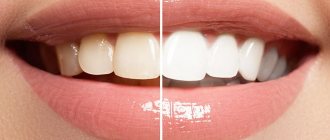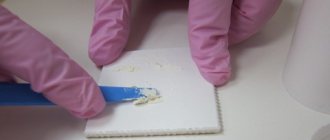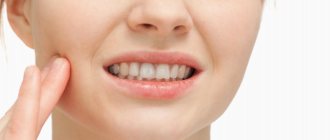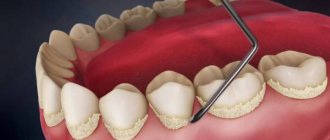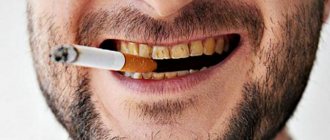Set on edge, set on edge: understanding the concepts
The word set on edge has deep roots; it comes from the old Russian verb “skomite”, which means “whining”, “to hurt”. In its modern meaning, soreness is the name given to painful sensations and a feeling of discomfort in the teeth or tongue. A sore throat appears from exposure of the teeth or oral mucosa to any irritant. Most often, spicy and sour foods. As a rule, an unpleasant symptom goes away quickly after eliminating the irritant (within 30 seconds), but sometimes it persists for quite a long time.
Important! Professional doctors believe that regardless of the frequency and duration of the discomfort, the symptom almost always indicates the presence of some kind of dental problem.
Finding out how serious it is: symptoms and stages
Dentists distinguish 3 stages of this condition: early, middle and advanced.
Early
A feeling of soreness appears when the temperature changes, that is, aching pain occurs as a reaction to hot or cold. This is evidence of the onset of caries or enamel defect. After removing the irritant, the discomfort and pain quickly disappear.
Average
In addition to the reaction to temperature changes, chemical irritants are added. The sore throat constantly appears from eating too sour or sweet foods. Lemons, oranges, apples, chocolate, sweets are not a complete list of foods that cause pain. Acid removes salts, thins and corrodes enamel.
Launched
As a result of the above, a sharp toothache appears. It lasts a long time and can only be stopped by using painkillers.
The main reasons for the development of dental pathology
When asked why the sore throat appears, doctors, as a rule, answer unanimously - increased sensitivity or, scientifically, dental hyperesthesia is to blame1. Hard tissues respond to various stimuli because they are weakened, demineralized, thinned, or destroyed.
A sore throat appears in your mouth for a reason. Here are the main reasons why enamel and dentin can weaken and begin to react negatively to food acids:
- increased accumulation of hard mineralized plaque and stone,
- serious dental diseases and non-carious defects: caries, pulpitis, periodontitis, erosion, wedge-shaped defect, hypoplasia, fluorosis. The problem can be caused by periodontal inflammation, for example, periodontitis, which in an advanced stage causes recession (loss) of the gums, exposure of the roots and necks of teeth,
- bad household habits: opening bottles with teeth, biting threads, cracking nuts and seeds. Those who bite their nails or constantly hold foreign objects (pens, pencils) in their mouth are susceptible to the problem.
- non-compliance with teeth brushing techniques, use of brushes with hard bristles, abuse of abrasive and whitening pastes,
- destruction of hard tissues due to injuries, impacts and falls,
- eating too cold, hot and hard foods, as well as a love of acidic foods (juice, berries, tomatoes, coffee, apples, sauces, marinades) and sweet carbonated drinks - all this makes the enamel more porous, thins it, contributes to the appearance of erosions,
- changes in hormonal levels and disruption of mineral metabolism: teeth set on edge often occurs in pregnant and lactating women, since hard tissues are weakened due to a lack of beneficial microelements and calcium leaching from the body. The problem also occurs in women during menopause,
- bruxism,
- smoking.
The problem may occur in those who have undergone dental treatment with braces or in people who have had home or even professional whitening done.
Complications of dental development during radiation and chemotherapy
Treatment of malignant neoplasms in childhood significantly affects dental development. It is important to understand that the development of teeth is one of the longest processes in the human body, because teeth are fully formed only by the age of 21–22 [4]. Tooth buds contain embryonic tissues that have the properties of intensively dividing and developing. If a child or teenager receives radiation or chemotherapy aimed at suppressing active cell growth, this inevitably affects the development of teeth. In particular, the impact manifests itself as follows:
- the resistance of teeth to cariogenic factors decreases;
- the constancy of the composition (homeostasis) of the oral fluid changes, including its cleansing properties, the protective function and content of trace elements and minerals involved in the remineralization of enamel and others decreases;
- teething is delayed;
- the risk of developing dental anomalies increases, for example, underdevelopment of tooth roots, microdentia, impaired enamel formation, and the formation of cavities;
- the rudiments of teeth die, which leads to their absence, while the likelihood of tooth loss is especially significant when chemotherapy is administered before the age of 9 years [4].
Children who have undergone chemotherapy should be routinely examined by a dentist at an early age (optimally at the age of 6 years, when the buds of all teeth are normally well mineralized and visible on radiographs, and for older children - after completion of chemotherapy) for timely diagnosis of edentia and prevention secondary deformation of the dental arches
Korolenkova M. V., Ph.D., pediatric dentist, Central Research Institute of Dentistry and Maxillofacial Surgery[4]
Why does the tongue set on edge?
Some patients complain not only of teeth set on edge, but also of increased sensitivity of the tongue when eating sour foods. In this case, the pathology may be caused by a disease such as glossitis. In this case, the tongue may have cracks, ulcers or open wounds that bleed or are covered with plaque.
The problem may arise due to injury to a muscle organ as a result of biting, malocclusion, wearing a piercing, or a burn. Due to the presence of damaged and chipped teeth in the mouth, poorly installed dentures, crowns and worn fillings.
How pathology manifests itself at different stages
Doctors say that the appearance of a sore throat, namely pain and discomfort while eating sour food, is not even the first stage of the disease, but the second.
- The first or early stage of enamel hyperesthesia (hypersensitivity) is characterized by the following symptoms: hard tissues react to thermal stimuli, namely cold and hot temperatures of food (drinks).
- If you have the second, or moderate stage, then the tissues react not only to sour foods, but also to sweet, salty, and spicy foods.
- At the third, or advanced stage, pain and discomfort can be caused by any mechanical impact, for example, brushing and eating solid food.
Methods to help relieve the condition at home
If you periodically have a sore throat, then you will find useful tips that will help you quickly get rid of it at home.
Alkaline mouth rinses
Alkaline agents help quickly neutralize the effect of acid. To get rid of sore throat after eating acidic food, simply rinse your mouth with a solution of soda, milk or mineral water without carbonate, but with bicarbonate in the composition.
Eliminating irritating foods from your diet
If you don’t know how to remove the soreness on your teeth, then simply stop eating too sour and spicy foods, or reduce their consumption to a minimum. Remember that acidic foods and drinks are an additional factor contributing to the destruction and erosion of enamel, irritation and damage to the oral mucosa.
On a note! Try replacing acidic foods with ones that have a more neutral acid level. For example, if you like apples, you can choose less sour or not sour varieties.
Drinking sour drinks through a straw
Start drinking freshly squeezed juices and fruit drinks through a straw. This will help reduce the area exposed to the irritating factor.
Strengthening enamel
At home, you can use pastes for sensitive enamel and remineralizing compounds (Sensodyne, ROCS Sensitive Instant Relief or Medical Minerals, Colgate Sensitive Pro-Relief, PresiDENT Sensitive Plus). Today, such pastes are in the line of every budget and premium manufacturer.
It is necessary to strengthen the enamel not only from the outside, but also from the inside. Vitamin and mineral complexes will help with this, as well as foods rich in calcium, phosphorus, potassium and magnesium.
Stages of development of the pathological condition
The sore throat can manifest itself with varying degrees of intensity. Therefore, in dentistry, this pathological condition is divided into the following stages:
- initial – teeth react sharply to temperature factors, including sudden changes,
- medium - at this stage, the enamel becomes susceptible not only to hot and cold, but also to chemical irritants. In such cases, a sore throat on the tongue and teeth occurs immediately after eating foods high in acids or sugars, including apples, citrus fruits, desserts and other delicacies,
- advanced – painful sensations become more intense and appear when exposed to all of the above factors. Pain also occurs with mechanical irritation, for example, while brushing teeth or biting into hard foods.
This condition can occur after eating acidic foods.
Only a specialist can correctly diagnose the stage. You will need to undergo appropriate diagnostics so that the doctor can prescribe adequate treatment. Sometimes light therapy with rinses is enough, but in other cases it is necessary to resort to more radical measures, including restoration with veneers or crowns.
Ways to solve problems in dentistry
Experts believe that it is still better to treat sore throat not at home, but in dentistry. Because only a doctor can conduct a detailed diagnosis and establish the true cause of the problem.
How to remove the soreness on your teeth with the help of a dentist and make sure that the problem does not appear? Depending on the examination results and the clinical situation, the specialist may prescribe the following procedures:
- professional oral hygiene: carried out if there is soft and hard bacterial plaque on the teeth, which is the cause of many dental diseases that provoke increased sensitivity of the enamel,
- fluoridation and remotherapy: after these manipulations, the protective properties of hard tissues increase, their strength and resistance to irritating factors increases. During the procedure, the doctor seals the smallest cracks in the enamel, making its surface smooth and shiny,
- treatment of caries, pulpitis, periodontitis, gingivitis and periodontitis,
- installation of veneers and lumineers: microprosthetics with thin overlays is justified in cases of enamel hypersensitivity and the presence of other minor defects (chips, cracks, stains, gaps between teeth, unsightly shade, slight curvature and irregular shape of some teeth),
- prosthetics with crowns: this radical method is suitable only for those patients whose teeth are severely damaged,
- making and wearing night guards for bruxism,
- correction of bite pathologies with braces, trainers, aligners.
Why an unpleasant sensation occurs - possible reasons
Since sore throat most often becomes a consequence of increased sensitivity of the teeth, it is first of all worth understanding the causes of this pathological condition. The following phenomena and conditions are the prerequisites for the development of hyperesthesia:
- carious destruction,
- inflammatory processes in periodontal tissues,
- chips and cracks in the enamel as a result of mechanical, chemical or temperature effects,
- intensive formation of dental plaque,
- pathological abrasion of enamel and its thinning.
On a note! Hyperesthesia often appears when wearing braces and worsens after their removal. Upon completion of the course of orthodontic correction, it is necessary to undergo the procedure of Prof. hygiene.
Cracks in teeth can cause this symptom
As a result of aggressive exposure to chemical, temperature or mechanical factors, the enamel becomes thinner and microcracks form on its surface. Therefore, proper therapy should be aimed primarily at restoring the structure of dental tissues and saturating them with useful minerals.
To prevent the development of hyperesthesia, it is necessary to maintain oral hygiene, brush your teeth twice a day, using the correct technique and using an individually selected brush. In this regard, it is better to consult with your dentist - he will help you choose the appropriate toothpaste and bristle hardness. You should also avoid sudden temperature changes in food and drinks, and every time after acidic foods and sweets, rinse your mouth thoroughly with plain water or a prophylactic solution.
Often, patients with dentures and crowns notice a foreign taste in the mouth. This point is usually associated with metal components in the design of prosthetic devices. Upon contact with salivary fluid, the metal oxidizes, which leads to the appearance of a taste. In such a situation, it is better not to postpone a visit to the doctor - perhaps it is time to replace the crowns or dentures.
Treatment of a sore tongue
If your teeth are set on edge, then you now know what to do. But if you are bothered by such unpleasant sensations on the tongue, then, as mentioned above, in most cases this indicates glossitis. There are many types of glossitis (allergic, herpetic, ulcerative, viral, hypertrophic, and so on). Each type of pathology is treated differently. To accurately determine the type and cause of this disease, you need to consult a doctor.
Read the article on the topic: “Symptoms, treatment, dental care for glossitis.”
Depending on the cause of the pathology, the doctor will prescribe a list of medications: antiseptics, antibiotics, ointments and antifungals.
Prevention is easier than cure - measures to prevent the problem
Professional doctors believe that sore throat can be easily avoided if you follow a number of preventive (prophylactic) measures.
Diet restrictions
You should not alternate cold and hot foods or get too carried away with sweet, spicy, salty, and sour foods. It is better to first separate solid foods into several small pieces. It is necessary to exclude from the diet carbonated drinks with phosphoric acid (Coca-Cola, Sprite, Fanta), which destroy and thin the enamel. You should also avoid eating sticky foods, crackers, chips and popcorn.
It must be remembered that teeth set on edge often appears due to careless treatment of enamel, so forget about cracking nuts and husking seeds with your teeth.
Using the right products to clean your teeth and gums
It will be better if you purchase personal hygiene products (paste, type of brush, type of floss and irrigator) after consulting a dentist, who will give valuable advice. The doctor will be guided by the condition of the gums, teeth and mucous membranes, and the presence of certain diseases.
Teeth whitening only in dentistry
Give preference to professional methods and whitening products used in dentistry. Remember that whitening pastes and folk remedies for home use (soda, salt, charcoal, lemon) can cause significant harm to the enamel and mucous membranes of the oral cavity, and the effect will be much more modest than what you get in dentistry.
Features of the treatment of oral diseases during radiation and chemotherapy
It is important for the patient to undergo a preventive examination and consultation with a dentist in advance, before starting radiation or chemotherapy. This is due to the fact that mandatory examination of such patients should include an X-ray or tomographic examination of the condition of the bones of the jaws and teeth, which makes it possible to exclude the development of a pathological process in them.
If a patient requires oral surgery (such as tooth extraction) or dental prosthetics, treatment strategies should be discussed with the treating oncologist and dentist. As a rule, surgical interventions are recommended to be performed 2–3 weeks before the start of antitumor therapy. In addition, before starting the course of treatment, it is necessary to perform sanitation of the oral cavity (cure carious cavities), and it is also advisable to conduct a course of remineralization of the enamel.
Due to the increased risk of bleeding, poor wound healing, and the possibility of inflammation or infection when treating dental diseases in patients receiving radiation or chemotherapy, dentists must take a number of precautions.
- When examining the oral cavity, the doctor should pay attention to the condition of the gums and ask the patient about cases of inflammation or bleeding.
- All interventions must be carried out with monitoring of blood tests, in particular the level of leukocytes.
- All interventions, from local anesthetic injections to the canal depulpation procedure, must be performed in the most gentle and careful manner possible.
- Consultations between the dentist and the treating oncologist are advisable for a correct assessment of the patient’s condition.
- If necessary, a course of antibiotics is given before treatment, which reduces the risk of infection.

